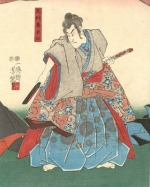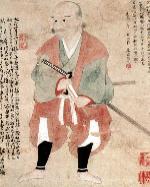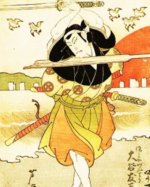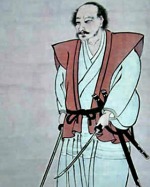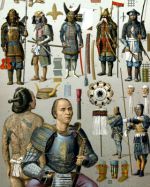The Rise and Fall of Yoshitsune Minamoto
Talk the Talk
By 1184 at the age of 25, Yoshitsune Minamoto had been granted the rank of So-daisho (General of the Army).
Walk the Walk
According to samurai legend, as a boy, Yoshitsune would sneak away from the monastery where he was raised and train in a secret spot in the woods.
There, he is said to have received combat training from the Tengu (pictured above), mythical creatures and the keepers of the secrets of the martial arts who had human-like bodies, arms and legs and the beak, wings and eyes of a hawk.
There, he is said to have received combat training from the Tengu (pictured above), mythical creatures and the keepers of the secrets of the martial arts who had human-like bodies, arms and legs and the beak, wings and eyes of a hawk.
Samurai Facts
As with many great warriors, the legend of Yoshitsune Minamoto lived on after his death.
It has even been suggested that he survived the battle against Yasuhire's forces and escaped to Mongolia where he took on a new name, Genghis Khan, though there is almost certainly no truth to this.
Another story stated that when Yoritomo died from injuries sustained when he fell off his horse in 1199, it was a result of the animal being startled by the vengeful ghost of the brother he betrayed, Yoshitsune.
It has even been suggested that he survived the battle against Yasuhire's forces and escaped to Mongolia where he took on a new name, Genghis Khan, though there is almost certainly no truth to this.
Another story stated that when Yoritomo died from injuries sustained when he fell off his horse in 1199, it was a result of the animal being startled by the vengeful ghost of the brother he betrayed, Yoshitsune.
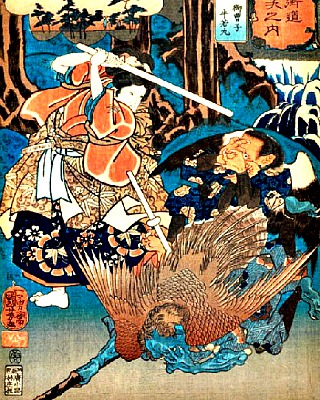 Yoshitsune Minamoto (1159 – 1189) was a legendary samurai warrior from the Heian Period who was instrumental in bringing an end to the rule of the Taira Clan and helping his brother, Yoritomo, become the most powerful man in the country. The problems can be said to have started for the Taira when their leader, Kiyomuri Taira, crushed a rebellion by Yoshitsune’s father Yoshitomo Minamoto in 1160 and executed him.
Yoshitsune Minamoto (1159 – 1189) was a legendary samurai warrior from the Heian Period who was instrumental in bringing an end to the rule of the Taira Clan and helping his brother, Yoritomo, become the most powerful man in the country. The problems can be said to have started for the Taira when their leader, Kiyomuri Taira, crushed a rebellion by Yoshitsune’s father Yoshitomo Minamoto in 1160 and executed him.Unusually for the time in samurai history, the children of the defeated traitor were allowed to live and the infant Yoshitsune was sent to a monastery on Kuramayama Mountain north of Kyoto to be raised as a trainee monk. However, by the time he was eleven years old, the youngster had no intention of becoming a holy man and swore to take revenge for his father’s death.
The Rise of Yoshitsune Minamoto
Yoshitsune studied any available text on martial arts he could find, including Sun Tzu’s Art of War and practised his fighting skills as often as possible, (even though this meant neglecting his religious studies much to the annoyance of the monks responsible for raising him).By the time he was fifteen years old, the young samurai was an expert fighter and left the monastery in order to begin exacting his revenge on Kiyomuri, honing his skills on his travels by fighting bandits and Taira soldiers at any given opportunity. It was during this time he met up with his first loyal retainer, a warrior monk by the name of Benkei who would fight alongside Yoshitsune and become his most trusted friend.
According to samurai legend, the monk had set out on a pilgrimage vowing to collect a thousand swords by taking them from their owners after defeating them in a duel. So the story goes, he only had one left to add to his collection when he came across the young samurai but Benkei would soon realise that he had finally met his match. The two fought (pictured below) and even though he was a great warrior in his own right, Benkei was quickly defeated and brought to his knees. However his fighting skills had earned the respect of Yoshitsune who spared his life and from that day to the day they both died, the warrior monk became his faithful friend and servant.
Meanwhile, Yoritomo, Yoshitsune’s brother and heir to the Minamoto holdings had worked his way into a position where he could begin to take his own revenge for their father’s death. Despite being raised by the Taira, he had never forgiven Kiyomuri and by 1180 had amassed forces against him, making his brother one of his trusted generals soon after. This signalled the beginning of the Genpei War and the beginning of the end of the Taira Clan’s hold on power in Japan and the end of the Heian Period.
Yoshitsune in the Genpei War
In 1184, Yoritomo sent Yoshitsune to fight their cousin, Yoshinaka, who after winning one of the most decisive victories of the war for the Minamoto Clan a year earlier at the Battle of Kurikara, wanted to assume leadership of the clan for himself. Yoshinaka’s forces were defeated in the ensuing battle and he was forced to flee with a small band of followers that included one of the few examples of a female samurai, Tomoe Gozen.However, they were soon tracked down and defeated which resulted in Yoshinaka being made to commit seppuku. Yoshitsune went on to become one of the most prolific generals of the Minamoto campaign, earning numerous victories over the Taira Clan and pushing deep into their territory. Any real threat the Taira held over the Minamoto Clan came to an end in 1185 when the eight-year-old Emperor, Antoku, was forced to flee to waiting ships after Yoshitsune attacked his stronghold with just a hundred men. This led to a naval fight known as the Battle of Dan no Ura a few days later which at first seemed to be going in favour of the Taira.
However, when one of their generals defected and revealed which ship held the emperor, the fortunes of Yoshitsune and his men turned and they gained the upper hand. Realising all was lost, Antoku’s grandmother took him into her arms, said a prayer and jumped into the sea; neither was ever seen again. Of the remaining Taira forces, most of those that had not already been killed in the battle followed their emperor into the sea in an act of mass suicide that illustrates the level of loyalty lower-ranking samurai warriors felt towards their Imperial leader, even though by this time the position was little more than a ceremonial one.
By now, the clan leader was Munenuri Taira and in an act that showed that Shoguns did not always live up to their own codes of honour, he refused to follow the emperor and his men into the sea. However, he was promptly pushed in and despite trying to swim to safety, was later captured and killed. The Taira never recovered from the losses of that day and afterwards, their dominance was all but over and the Kamakura Period began.
The Fall of Yoshitsune Minamoto
Soon after the Battle of Dan no Ura, Yoritomo turned on Yoshitsune though the actual reason for this is unclear. Some contemporary sources state that he had become rebellious as a result of not receiving the honours and titles he felt he had earned through the victories he had won in the Genpei War.Others believed Yoshitsune was loyal to his brother right up until the end of his life and was just a victim of Yoritomo’s suspicious nature and overwhelming ambitions, which led him to eliminate any possible threat to his leadership, whether real or imagined. In a letter to one of his brother’s chief ministers, Yoshitsune complained:
I became the object of the most damning slanders, in consequence of which my great exploits have been ignored. I, Yoshitsune, though innocent of all offences, have incurred blame; though worthy of honour and guilty of no mistake, I have fallen into his Lordship’s disfavour...My armour and helmet were my pillow; my bow and arrows were my trade….Realising that only through the help of the Buddhas and the gods could I hope that my appeal might succeed, I inscribed oaths on talismans of various temples and shrines, swearing by the gods of the great and small shrines in Japan and by the spirits of the underworld that I never for a moment harboured any evil ambitions; and all these pledges of loyalty I submit yet I receive no pardon.
The monk was surrounded but even though he had a multitude of arrows protruding from his armour, no one dared to approach until eventually, they realised he was already dead. When Benkei finally fell, Yoshitsune killed his own wife and children to prevent them having the dishonour of being captured; he then turned his blade on himself and committed seppuku. His pregnant mistress was however captured and while she was allowed to live, her baby was killed just after birth to prevent any chance of a vengeful heir coming after Yoritomo in years to come, as he and Yoshitsune had once done themselves.
Written by Andrew Griffiths – Last updated 28/10/2023. If you like
what you see, consider following the History of Fighting on social media.
Further Reading:
Cook, H. 1993. Samurai – The Story of a Warrior Tradition. London. Blandford Press.Henshall, K. 2004. Second Edition. A History of Japan – From Stone Age to Super Power. Hampshire. MacMillan Press.
Minamoto Yoshitsune. [Internet]. 2013. Encyclopaedia Britannica. Available from: http://www.britannica.com/EBchecked/topic/383453/Minamoto-Yoshitsune [Accessed November 4, 2013].
Seal, F.W. [Internet]. 2012. Minamoto Yoshitsune 1159-1189. Samurai Archives. Available from: http://www.samurai-archives.com/yoshitsune.html [Accessed November 04, 2013].
Totman, C. 2005. Second Edition. A History of Japan. Cornwall. Blackwell Publishing.
More Samurai History
Samurai History Home
A brief overview of the history of the samurai, looking at the rise and development of the leading social class in Japan and some of the cultural traits than made the samurai warriors unique such as their weapons and their code of ethics, known as bushido.
A brief overview of the history of the samurai, looking at the rise and development of the leading social class in Japan and some of the cultural traits than made the samurai warriors unique such as their weapons and their code of ethics, known as bushido.
The Heian Period
The Heian Period was a time of major change in Japan as it saw the rise of a new warrior elite, the Samurai. The leaders of this new power would dominate the politics of the country for centuries and would even supplant the power of the Emperor, though not without a struggle.
The Heian Period was a time of major change in Japan as it saw the rise of a new warrior elite, the Samurai. The leaders of this new power would dominate the politics of the country for centuries and would even supplant the power of the Emperor, though not without a struggle.
Tomoe Gozen – Female Samurai Warrior
Tomoe Gozen is a rare example of a female Samurai warrior and is believed to have been involved in the Gempei wars (1180 – 1185). She fought alongside her Master, Minamoto Yoshinaka, though it is unclear how much of her story is actually true.
Tomoe Gozen is a rare example of a female Samurai warrior and is believed to have been involved in the Gempei wars (1180 – 1185). She fought alongside her Master, Minamoto Yoshinaka, though it is unclear how much of her story is actually true.
The Kamakura Period
A look at the change and turmoil experienced by the ruling elite of Japan during the Kamakura Period and the Kemmu Restoration. A series of civil wars and two invasions from the Mongols saw powershifts not only between rival families, but also between the titles of the Emperor, the Shogun and the Regent.
A look at the change and turmoil experienced by the ruling elite of Japan during the Kamakura Period and the Kemmu Restoration. A series of civil wars and two invasions from the Mongols saw powershifts not only between rival families, but also between the titles of the Emperor, the Shogun and the Regent.
The Mongols vs. The Samurai
While the samurai warriors of the late thirteenth century were formidable warriors in their own right, when faced with the onslaught of the Mongol Hordes they seemed to be fated to lose. They were outclassed in every way by however things did not go according to plan for the foreign invaders.
While the samurai warriors of the late thirteenth century were formidable warriors in their own right, when faced with the onslaught of the Mongol Hordes they seemed to be fated to lose. They were outclassed in every way by however things did not go according to plan for the foreign invaders.
The Japanese Samurai Sword
The samurai sword, it is said, was believed to contain the soul of the warrior who owned it. While this is probably an over romanticised view, it is true to say that there was a spiritual connection not only for the wielder of the katana, but also for the sword smith and his creation.
The samurai sword, it is said, was believed to contain the soul of the warrior who owned it. While this is probably an over romanticised view, it is true to say that there was a spiritual connection not only for the wielder of the katana, but also for the sword smith and his creation.
The Muromachi Period
The Muromachi Period was a time of turmoil in Japan that can be spilt into two separate eras. At the beginning of the period, the government was divided into two separate entities sparking the Northern and Southern Courts Era. Then, after a brief period of relative stability, the Warring States Era began.
Tsukahara Bokuden
Tsukahara Bokuden was a samurai warrior who lived in the 16th century. In his early days he exemplified what a samurai should be and was known as one of the fiercest warriors around. However in later life, Bokuden would take on a more pacifist philosophical stand point.
Tsukahara Bokuden was a samurai warrior who lived in the 16th century. In his early days he exemplified what a samurai should be and was known as one of the fiercest warriors around. However in later life, Bokuden would take on a more pacifist philosophical stand point.
The Death of a Samurai
The manner in which a samurai died was very important and if possible, it would be during combat in a way that would be told in samurai stories for years to come. Failing that, he should die in some other service to his lord or if his honour depended on it, in a ritualistic suicide known as seppuku.
The manner in which a samurai died was very important and if possible, it would be during combat in a way that would be told in samurai stories for years to come. Failing that, he should die in some other service to his lord or if his honour depended on it, in a ritualistic suicide known as seppuku.
The Duels of Miyamoto Musashi
Miyamoto Musashi is
one of the most acclaimed samurai that ever lived. While undertaking a warrior’s pilgrimage, he fought in over 60 duels dispatching the best swordsmen in a given area, often in fights to the
death.
The Samurai at War
The main business of the samurai was war and while tactics and weapons changed through the years, the willingness to die for their lord was a constant. In return, they could gain riches and status, as well as the best of them gaining a kind of immortality by having stories told about them for centuries to come.
The main business of the samurai was war and while tactics and weapons changed through the years, the willingness to die for their lord was a constant. In return, they could gain riches and status, as well as the best of them gaining a kind of immortality by having stories told about them for centuries to come.
The images on this site are believed to be in the public domain, however, if any mistakes have been made and your copyright or intellectual rights have been breeched, please contact andrew@articlesonhistory.com.

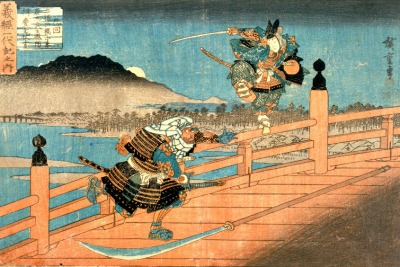
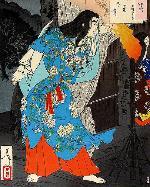
.jpg?timestamp=1584002402301)
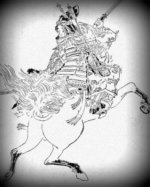
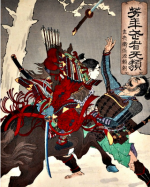
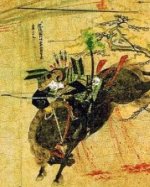
 thumb.jpg?timestamp=1584003027688)
